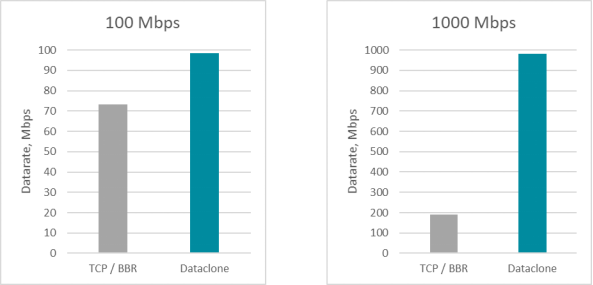Dataclone: A Superior Alternative to TCP/BBR
Results Of Lab Experiments
Today the most commonly used file transfer solutions like FTP are based on the TCP protocol created in 1980. Since then, there have been a number of enhancements, including the most promising congestion control algorithm from Google, called BBR. While most congestion control algorithms are based on packet loss, BBR is designed to respond to actual congestion. That changes claim to improve network performance and provide better download speed over the same network. That is really so – BBR works better than all other versions of TCP.
Our interest is to check whether the achieved network performance by BBR can serve as a transport for wide area networks with a high capacity.
The following experiments compare the data rate on cross-continental file transfers via TCP/BBR and Dataclone based on RMDT protocol. File-transfer application rsync (similar to FTP) is used to record the rate of file transfer by means of TCP. Two servers are available in Germany with access to the public Internet and a rate of up to 100 Mbps and up to 1 Gbps. The third server is located in India with Internet access of up to 10 Gbps. All servers are hardware-based with Ubuntu 18.04 LTS on board. Tuning procedures to maximize TCP performance on long distances are performed on all machines. The current channel is described as follows:
- RTT is approximately 155 ms
- End-to-end capacity is 100 Mbps and 1 Gbps accordingly to servers in Germany
- Packet loss rate has bursty behavior, up to 5% within a single RTT period, where the mean packet loss rate is about 0.5%
In each test, a 30 GB file was transferred 10 times, the median values are shown in the figures below.

Figures clearly show that performance of rsync over TCP/BBR on the 100 Mbps path achieving almost 75 % of the available capacity. However, the performance of TCP on the link of higher capacity – 1Gbps, lies below 200 Mbps and consumes less than 20% of available bandwidth. In contrast, Dataclone achieves almost 100% utilization under the same conditions. This simple example demonstrates that TCP with BBR algorithm fits to the low till medium size jobs, however full performance of available wide area path can be easily archived by Dataclone.
Want to know more?
Drop us a message
You must be logged in to post a comment.